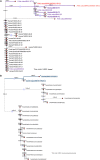SARS-CoV-2 Transmission from Human to Pet and Suspected Transmission from Pet to Human, Thailand
- PMID: 36314788
- PMCID: PMC9667761
- DOI: 10.1128/jcm.01058-22
SARS-CoV-2 Transmission from Human to Pet and Suspected Transmission from Pet to Human, Thailand
Abstract
Coronavirus disease 2019 (COVID-19), caused by severe acute respiratory syndrome coronavirus 2 (SARS-CoV-2), has been the cause of human pandemic infection since late 2019. SARS-CoV-2 infection in animals has also been reported both naturally and experimentally, rendering awareness about a potential source of infection for one health concern. Here, we describe an epidemiological investigation of SARS-CoV-2 infection in 639 cats and 224 dogs throughout multiple waves of COVID-19 outbreaks in Thailand. To indicate the potential source of infection, we performed SARS-CoV-2 genomic sequencing of samples obtained from pets and contacted humans, combined with in-depth interviews to support the epidemiological investigation. In the tested animals, SARS-CoV-2 RNA was present in 23 cases (19 cats and 4 dogs). Whole-genome sequencing of selected samples showed various SARS-CoV-2 variants of concern, which included the original European lineage (B.1), Alpha (B.1.1.7), Delta (B.1.617), and Omicron (BA.2). Among SARS-CoV-2-positive pets, 34.78% had evidence of contact with infected humans. Together with genomic analysis and an overlapping timeline, we revealed evidence of viral transmission from infected humans as the primary source, which spread to household cats via an undefined mode of transmission and most likely circulated between cohoused cats and caretakers within the weeks before the investigation. The SARS-CoV-2 surface glycoprotein (spike gene) obtained from caretakers of individual cats contained sequence signatures found in the sequences of infected cats, indicating possible exposure to the virus excreted by cats. Although pet-to-human transmission of SARS-CoV-2 is considered relatively rare, our study provides suspected episodes of human infection from animals that were initially infected through contact with infected humans.
Keywords: COVID-19; SARS-CoV-2; animal; cat; coronavirus; zoonotic infections.
Conflict of interest statement
The authors declare no conflict of interest.
Figures




References
-
- Huang C, Wang Y, Li X, Ren L, Zhao J, Hu Y, Zhang L, Fan G, Xu J, Gu X, Cheng Z, Yu T, Xia J, Wei Y, Wu W, Xie X, Yin W, Li H, Liu M, Xiao Y, Gao H, Guo L, Xie J, Wang G, Jiang R, Gao Z, Jin Q, Wang J, Cao B. 2020. Clinical features of patients infected with 2019 novel coronavirus in Wuhan, China. Lancet 395:497–506. 10.1016/S0140-6736(20)30183-5. - DOI - PMC - PubMed
-
- Holmes EC, Goldstein SA, Rasmussen AL, Robertson DL, Crits-Christoph A, Wertheim JO, Anthony SJ, Barclay WS, Boni MF, Doherty PC, Farrar J, Geoghegan JL, Jiang X, Leibowitz JL, Neil SJD, Skern T, Weiss SR, Worobey M, Andersen KG, Garry RF, Rambaut A. 2021. The origins of SARS-CoV-2: a critical review. Cell 184:4848–4856. 10.1016/j.cell.2021.08.017. - DOI - PMC - PubMed
-
- Zhou H, Ji J, Chen X, Bi Y, Li J, Wang Q, Hu T, Song H, Zhao R, Chen Y, Cui M, Zhang Y, Hughes AC, Holmes EC, Shi W. 2021. Identification of novel bat coronaviruses sheds light on the evolutionary origins of SARS-CoV-2 and related viruses. Cell 184:4380–4391.e14. 10.1016/j.cell.2021.06.008. - DOI - PMC - PubMed
Publication types
MeSH terms
Substances
Supplementary concepts
Grants and funding
LinkOut - more resources
Full Text Sources
Medical
Miscellaneous

